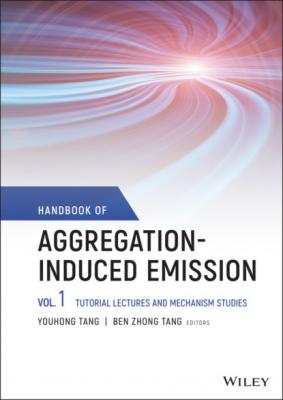Handbook of Aggregation-Induced Emission, Volume 1. Группа авторов
Читать онлайн.| Название | Handbook of Aggregation-Induced Emission, Volume 1 |
|---|---|
| Автор произведения | Группа авторов |
| Жанр | Химия |
| Серия | |
| Издательство | Химия |
| Год выпуска | 0 |
| isbn | 9781119642893 |
Three representative AIEgens, 9,10‐distyrylanthracene (DSA) [54], 2,3‐dicyano‐5,6‐diphenylpyrazine (DCDPP) [55], and cis,cis‐1,2,3,4‐tetraphenyl‐1,3‐butadiene (TPBD) [56] in both solution phase (PCM model) and crystal (QM/MM model), were investigated at the PBE0‐D3(BJ)/6‐31G(d) level [57]. According to the Franck–Condon principle, the maximum peak of the optical spectrum usually appears at the vertical transition point (Figure 2.5a); the Stokes shift (κ) between the absorption and emission maxima can be regarded as λtotal, which is the sum of the reorganization energy of the ground (λgs) and excited state (λes). Then, the emission energy can be written as Eem = Eabs − λtotal. Upon aggregate from solution, the shift of the emission spectrum can be regarded as:
(6)
The common red‐shift spectra of the ACQ molecule originate from ΔEagg − sol < 0 for both absorption and emission and the tiny change in reorganization energy (
Figure 2.5 (a) The schematic representation of the adiabatic potential energy surface of the S0 and S1, as well as the corresponding vertical excitation energies. (b) The relative wavelength of AIEgen in both solution and aggregated state.
The optical properties and reorganization energies are summarized in Table 2.4. It is clear that, upon aggregation, the change of absorption spectra is tiny, while the emission spectra blue‐shifted obviously. Thus, the κsol is much larger than κagg. According to the approximately equivalent relation between κ and λtotal, as shown in Table 2.4,
2.4.2 Resonance Raman Spectroscopy (RSS) vs Reorganization Energy
Resonance Raman spectroscopy (RRS) is a spectroscopic technique in which the incident laser frequency is close to the electronic transition of chromophore. RRS is able to provide the information of excited‐state properties. Under the Franck−Condon approximation and resonance condition, the RRS intensity σ(ωj) from the jth normal mode is proportional to reorganization energy λj times frequency ωj: σ ∝ ωjλj → σ/ωj ∝ λj [58, 59]. As discussed above, the reorganization energy is one key factor to determine kic, which plays an important role in the AIE mechanism. In this part, we use RRS to detect the aggregation effect on the reorganization energy during the nonradiative process and validates the above‐proposed AIE mechanism.
The AIEgen HPDMCb [60] and AIE‐inactive DCPP [55] (see Figure 2.3) were chosen as models to show the connection between RRS intensity and the reorganization energy [61]. By combining PCM and QM/MM models, the photophysical properties of these two compounds were studied in both solution and solid phases. It is found that the kr of HPDMCb is similar in both phases; while kic decreases by 4 orders of magnitude from 1.31 × 1011 to 2.29 × 107 s−1 upon aggregation, the corresponding ΦF increases to 78.0% from 0.07%, well consistent with the experimental results (see Table 2.5) [60]. For AIE‐inactive DCPP, the radiative and nonradiative decay rates and ΦF are insensitive to the aggregation (see Table 2.5). Analyzing the three factors for the nonradiative decay rate, it is found that both the nonadiabatic coupling and adiabatic energy gap are almost unchanged for HPDMCb and DCPP. Moreover, the reorganization energy of DCPP has a little change from solution to solid phase. Thus, the excited‐state decay process of DCPP is independent on the surrounding environment. Much differently, the reorganization energy of HPDMCb is significantly reduced from solution to solid phase, as shown in Figure 2.6a, which leads to the large decrease of kic and the obvious increase of ΦF in the solid phase. From Figure 2.6a, it is also seen that the frequencies of the low‐frequency modes (<100 cm−1) become ca. two to threefold larger upon aggregation; however, the reorganization energy of each mode reduces a lot. These suggest that the coupling between low‐frequency modes and the transition electrons is strongly decoupled upon aggregation, leading to the decrease of nonradiative decay rate. With the incident wavelength equal to the adiabatic excitation energy, the RRS plot of HPDMCb in both solution and solid phases is shown in Figure 2.6b, and the blue shift of the low‐frequency peaks with the relatively decreased RRS intensity fully reflects the change character of the reorganization energies. In addition, the high‐frequency normal modes are almost unresponsive to the environment, as shown in both reorganization energies and RRS signals for AIE‐active HPDMCb. Therefore, the above‐proposed AIE mechanism is successfully confirmed by RRS signals and the RRS can act as a good detection means of AIE property.
Table 2.4 The calculated spectral properties and reorganization energies corrected by zero‐point energy for DSA, DCDPP, and TPBD in solution and aggregate phase, respectively.
Source:
